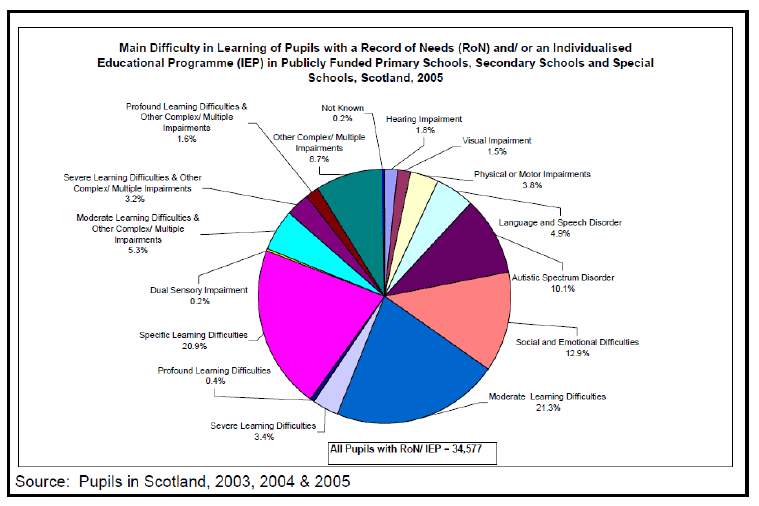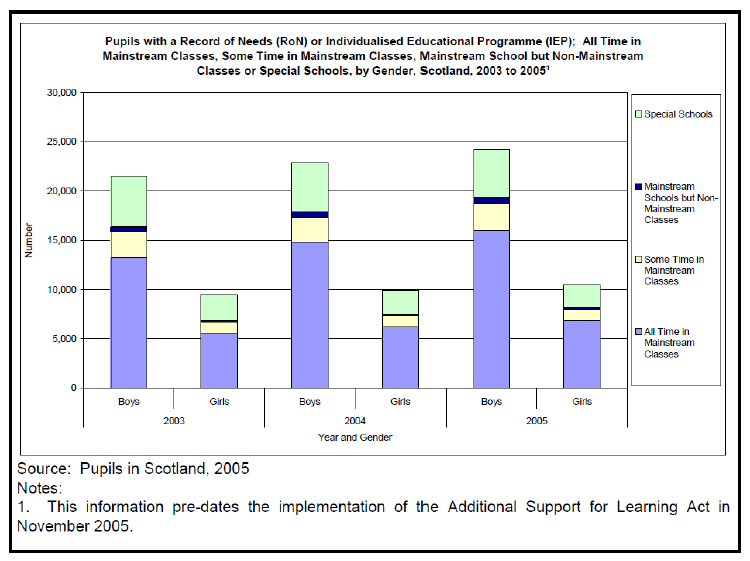Scottish Government Equality Outcomes: Disability Evidence Review
This evidence review was prepared to support the production of the Scottish Government's Equality Outcomes, with regard to disability.
3 School education
3.1 This section looks at the demographics of school children with disabilities, provision that is made for special educational needs in schools, attainment, areas of particular difficulty for disabled pupils, and post school destinations.
Demographics
3.2 The High Level Summary of Equality Statistics[10] illustrates the learning difficulties in school-age children in Scotland in 2005 (see Figure 1). Of those pupils with a Record of Needs and/or an Individualised Educational Programme, a fairly large proportion had moderate learning difficulties (21.3%) or specific learning difficulties (20.9%). Between 2003 and 2005, the proportion of pupils with a Record of Needs or Individualised Educational Programme remained fairly constant for most types of learning difficulty.

Figure 1: Learning disabilities in schools (Source: Scottish Government (2006) High Level Summary of Equality Statistics)
Provision for special educational needs in schools
3.3 The High Level Summary of Equality Statistics also explores the provision for special educational needs in schools, by gender (see Figure 2). It observes that a markedly higher proportion of pupils with a Record of Needs or Individualised Educational Programme are male, regardless of the type of classes or school they attend, and this is consistent over time. In 2005, 70% were male. Of all pupils with a Record of Needs or Individualised Educational Programme, the majority (66%) were in mainstream classes all the time, while 23% were attending special schools or special units/ classes all the time, and 11% were in mainstream classes sometimes. The 70:30 male to female ratio was constant across types of provision.

Figure 2: Special educational needs in schools, by gender (Source: Scottish Government (2006) High Level Summary of Equality Statistics)
Attainment
3.4 Scottish Government data show that school leavers with additional support needs (including those leaving special schools) in 2009/10 continue to have lower attainment, with only 11.7% of pupils with an additional support need achieving one or more Highers or better, compared to 52.6% for those with no additional support needs[11].
Areas of difficulty for pupils
3.5 In 2010/11, the rate of exclusions in Scotland for those with additional support needs was 121 per 1,000 pupils[12]. This was four times higher than for pupils with no additional support needs.
3.6 The (then) Scottish Executive's review of communication support needs (2007)[13] observes that children with communication support needs tend not to perform well in school, and are at increased risk of bullying due to peers' attitudes or lack of understanding. The transitions to secondary school and to further or higher education are identified as being particularly problematic, and the review advises that they should be planned in advance in consultation between the individuals concerned and professionals in both healthcare and education.
Post school destinations
3.7 Skills Development Scotland's School Leavers' Destination Report 2009/10[14] covers leavers from publicly funded secondary schools. It reports that 1.4% of all school leavers declared a disability, and 80% of them went into positive post school destinations. This compares to 86.8% for non-disabled pupils.
3.8 Scottish Government data show that leavers from publicly funded secondary schools with additional support needs in 2009/10 continue to be less likely to enter positive destinations on leaving school. It reports 71.3% in positive follow-up destinations compared to 86.1% for those with no additional support needs[15].
3.9 National Indicator data from Scotland Performs[16] show an improvement to 2012: although leavers with additional support needs are still less likely to be in a positive destination than those without, around 77% of school leavers with additional support needs are in a positive destination nine months after leaving school. This compares to 88% of those without additional support needs.
Contact
Email: Social Research
There is a problem
Thanks for your feedback